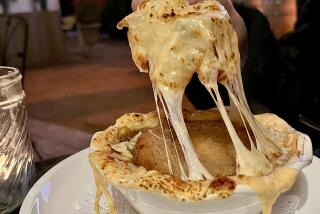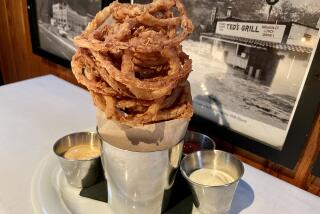Onions: Sweet ‘n’ Slow
- Share via
All anyone wants to talk about these days is quick cooking. Let’s slow down a minute. Last week, I cooked onions for two hours.
The result was a sweet, limp, golden mass. It’s not what you’re going for every time--or even most of the time--but it’s perfect for some things. And it’s a great exercise in self-control.
To begin, peel and slice the onions quite thin, less than 1/4 inch wide. Here’s a hint: When you peel the onions, rinse them in cold running water. This reduces the amount of sulfur compounds and keeps you from crying so much.
You can cut the onions somewhat thicker if you choose, but the thicker you cut them, the longer they will take to cook. If you cut them too thin, on the other hand, you’ll find they tend to scorch.
Put the onions in a large skillet that you can cover tightly. I know this seems like an impossible amount of onions, but you’ll find that when they’re cooked this long, onions reduce in mass like spinach. What seems way too much ends up looking like not nearly enough.
Add about 1/4 cup of oil and toss the onions with the oil in the cold pan. Don’t worry about measuring the oil too closely. Your goal here is to just barely coat the onions. You’ll find that almost all of the oil will end up being drained off anyway.
Starting with a cold pan gives you more control over how slowly you heat the onions. Cook things in a hot pan if you want to brown them quickly. If you want to cook them for a long time without browning them, start them in a cold pan.
Start the onions with the lid on over medium heat. The lid will help the onions cook more evenly--the top layer will be cooked almost as much as the bottom.
Stir every once in a while and watch as they release their water. After about 15 minutes, those onions that started out just barely moistened with olive oil will be swimming in liquid. Onions are about 90% water. When they’re raw, the water is held within the cells. As the water heats up, it expands, breaking down the cells, and empties into the pan.
Once the onions are limp and moist, reduce the heat to low and continue cooking under cover. You’re trying to stretch the process out as long as possible. The more slowly the onions cook, the more evenly they will cook. This way everything will caramelize at about the same time and the onions will be thoroughly cooked all the way through, rather than browned on the outside and crisp in the center.
How long will this take? It depends on what your concept of low heat is and how much time you have. It can be reasonably done in 45 minutes to an hour. If you’re in no hurry, the longer it takes, the safer you are.
The goal here is to brown the onions without blackening. Browning accentuates the sweetness of the onion. Blackening creates bitterness. Stir more frequently at the end. Your onions will probably start browning in the center of the pan first, so keep them moving every 5 minutes or so.
Now, you may be thinking that if the goal is a sweet cooked onion, why not start with a raw sweet onion? Don’t bother. Sweet onions--Vidalias, Mauis, Walla Wallas, etc.--actually contain less sugar than regular brown storage onions. They merely taste sweeter when they’re raw because they are also lower in the sulfur compounds that give onions their bite. Since those compounds are heat-sensitive, they go away quickly during cooking. After two hours--or even 15 minutes--they are gone.
When the onions are almost finished, take off the lid. This allows the last of the onion water to evaporate. At that point, you’ll find you have a mass of limp, golden onions swimming in olive oil. All of the other moisture will have evaporated. If you choose, you can drain the onions in a strainer to get rid of almost all the oil. (Save the oil, it’s great for frying potatoes.) Certainly in this recipe, in which it would make the tart crust soggy, you should drain the onions thoroughly.
Caramelized onions--that’s what these are--need to be used with care. They’re so sweet that unless they’re paired with similarly forceful ingredients, they will quickly overwhelm a dish.
Finished with a little red wine vinegar and some fresh sage, they’re perfect served with sauteed liver. Cooked with some cubed smoky bacon and a little rosemary, they make a hearty winter pasta sauce. In this case, I combined them with the hearty flavors of summer--green olives, fresh goat cheese and roasted red bell peppers.
If you want, you can cook the onions and make the tart shell the day before. That way you can finish everything in a flash. That’s my kind of quick cooking.
*
TART WITH CARAMELIZED ONIONS, GOAT CHEESE AND GREEN OLIVES
CRUST
3/4 cup bread flour
3/4 cup all-purpose flour
1/2 teaspoon salt
1/4 cup plus 2 tablespoons cold butter, cubed
2 tablespoons olive oil
3 tablespoons ice water
CARAMELIZED ONIONS
8 onions, thinly sliced
1/4 cup olive oil
1 small sprig rosemary
ASSEMBLY
Salt, pepper
1 (5 1/2-ounce) log fresh goat cheese
1/4 cup pitted green olives
1 red bell pepper, roasted, peeled and cut in thin strips
CRUST
Put bread flour, all-purpose flour and salt in food processor and pulse to combine. Add butter and olive oil and process until thoroughly cut into flour. Add ice water and process until dough forms ball. Remove from food processor and press into disk. Wrap tightly and refrigerate at least 1 hour.
CARAMELIZED ONIONS
Combine onions, olive oil and rosemary in large skillet. Cover and cook over medium heat until onions release their water, about 15 minutes. Stir, reduce heat to low and cook, stirring frequently, until onions begin to brown, about 1 hour. Remove lid and continue cooking over low heat, stirring frequently, until onions are deep brown, 30 to 45 minutes. Do not let onions scorch.
Set strainer over bowl. Remove rosemary and turn onions into strainer. Set aside until onions are drained of all oil.
ASSEMBLY
Remove tart dough from refrigerator and roll out 1/4-inch thick. Place in tart pan with removable bottom, folding double along edge to make sturdy rim.
Spoon onions across bottom of tart pan. Season lightly with salt and pepper. Dot goat cheese over onions. Scatter olives over goat cheese and arrange pepper strips over all.
Bake at 400 degrees until crust is browned and cheese is melted, about 45 minutes.
6 servings. Each serving:
494 calories; 497 mg sodium; 43 mg cholesterol; 32 grams fat; 43 grams carbohydrates; 11 grams protein; 1.46 grams fiber.
More to Read
Eat your way across L.A.
Get our weekly Tasting Notes newsletter for reviews, news and more.
You may occasionally receive promotional content from the Los Angeles Times.











